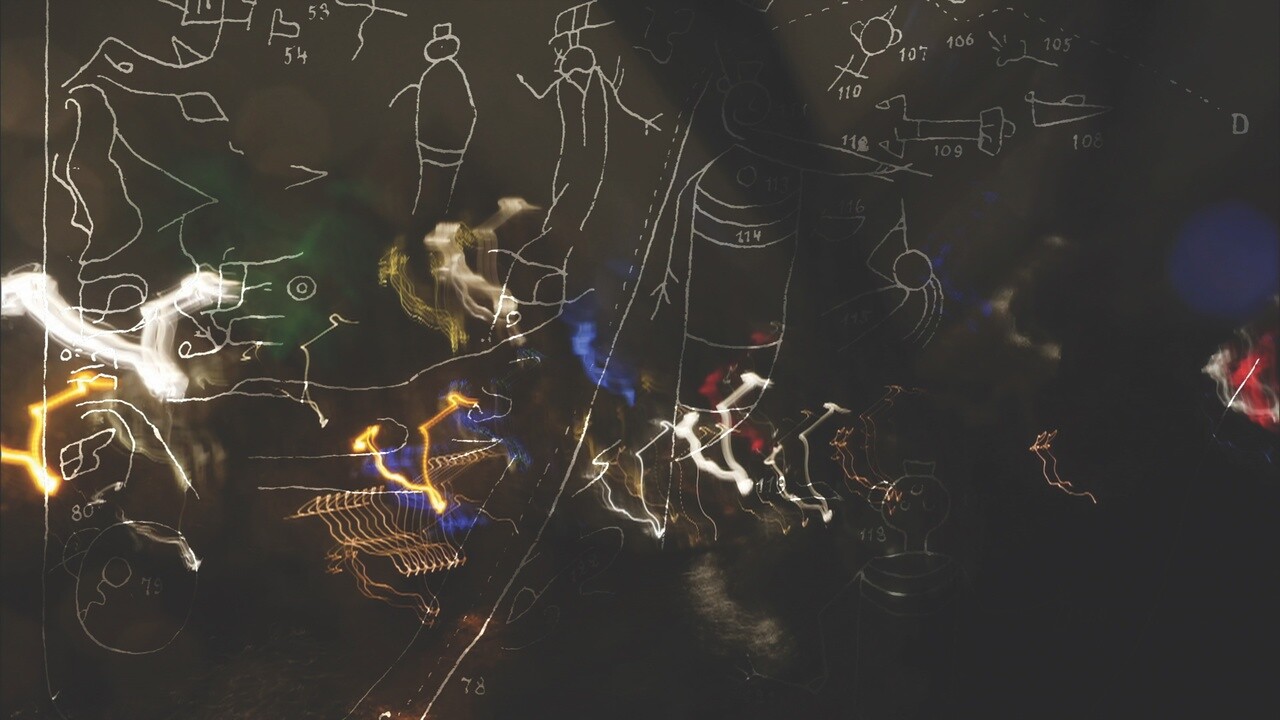

Still from Alexander Kluge, Time Perspective (2022).
In 1846, having had his attention drawn to the precise determination of the distance between the stars and the earth (and the amount of time it takes their light to reach the earth), the jurist Felix Eberty published his work The Stars and the History of the World. 1
He rightly supposed that–given ideal conditions for observation–a ray of light that had left the earth on Good Friday in the year 30 A.D. would still be moving away from us across the cosmos: which means that all of prehistory is stored in the universe in tracks of light. Thus the entire history of the world is traveling through the cosmos as MOVING SEQUENCES OF IMAGES (Eberty did not know the word cinema).
This conclusion, according to Eberty, could also be reversed. Assuming an observer had absolutely sharp vision he would be able to watch here and now the events of that far-off historical time by looking at ANTIQUE LIGHT arriving from a celestial body 2,000 light years away. Space is an “eternally indestructible and unerring archive of the images of the past.” And Eberty added that concepts such as omniscience and omnipresence thereby “attained a previously unknown clarity and transparency.”
In 1923, Albert Einstein wrote an introduction to a new edition of Eberty’s writings. He wrote that this little book presents “on the one hand a critical attitude to the conventional concept of time … and on the other it also shows how the theory of relativity, itself often accused of leading to bizarre conclusions, can in fact itself save us from some very strange ones.” Einstein is here referring to the fundamental assertion of the special theory of relativity that a traveler in time cannot overtake a light wave because the speed of light remains constant.
Einstein’s introduction was read at a conference of astrophysicists and philosophers in Honolulu. In a paper countermanding this argument, the astronomer Andreas Küppers from Harvard pointed out that the latest discovery, namely that of NEGATIVE ENERGY (which flows in the opposite direction to gravitational pull), relativizes the barrier described by Einstein to a COSMIC UNIVERSAL CINEMA. A ray of negative energy in fact could very well return information in the opposite direction to that of a ray of light, albeit not in the form of photons. And so now the only problem stopping us from realizing Eberty’s idea is that we can currently neither see nor decipher DARK ENERGY (which probably represents a fluctuation of the vacuum).
–You mean that 217 light years away from here there are light waves that left the earth (which in this case functions rather in the manner of a cinema projector) at the time of the French Revolution. Assuming it would be possible for an observer to “see” this ray of light, how would he be able to capture it? It is fleeting.
–The French astronomer Flammarion expanded on the ideas of Eberty on just this point: He called for a star with a light-sensitive surface, e.g. made of iodine (as in a dark room); it should have the form of a rotating cylinder. The events would be permanently “written onto it.”
–A kind of cosmic poster column? But would every new inscription erase the previous one?
–As with an ancient papyrus which is written over, we’ll be able to deal with the problem: we’ll read the writing on top, and below. With an x-ray.
–But for there to be any news (assuming we can solve all these problems) from, for example, August 1, 1798, concerning the explosion of the huge ship L’Orient, the sky over Aboukir would have to have been cloudless.
–It was clear on that night. Which is why we are awaiting clarification of the question as to whether there was a single explosion or two.
–But during the decisive moments of the French Revolution the sky above Paris was obscured by clouds.
–With an infrared device we can see through clouds.
–But what you’ll first see is a wide-angle image. What can you see of a revolution in such a comprehensive view? And so much of it takes place behind closed doors.
–Don’t underestimate our ability to enlarge sections. Imagine that a door opens, light escapes from the Assembly, at first sideways and then skywards. The secret services have solved many such problems on how to make things visible.
The scientists became more and more excited as they discussed these things at the conference. It seemed certain to them that the images of all previous ages stream past and through us. And in turn that was of particular interest to the philosophers, who are themselves always historians: they wish they already had such a UNIVERSAL CINEMA.
–You mean that the pictures of this totality, even if we haven’t seen them yet, influence us?
–How could something like that not have an influence?
–You mean our eyes can’t decipher it but we still sense it?
–We may not sense it, but this cinema flows through us.
–That’s what I mean.
–Although we don’t know what its effects are.
This text is republished on the occasion of Phoenix Cinema: Meeting with Alexander Kluge, a series of screenings and discussions that includes physical events at e-flux Screening Room and ongoing online screenings on e-flux Film platform, running from June 13 to July 17, 2024. For access to all Alexander Kluge’s films streamed online, please visit e-flux.com/film.